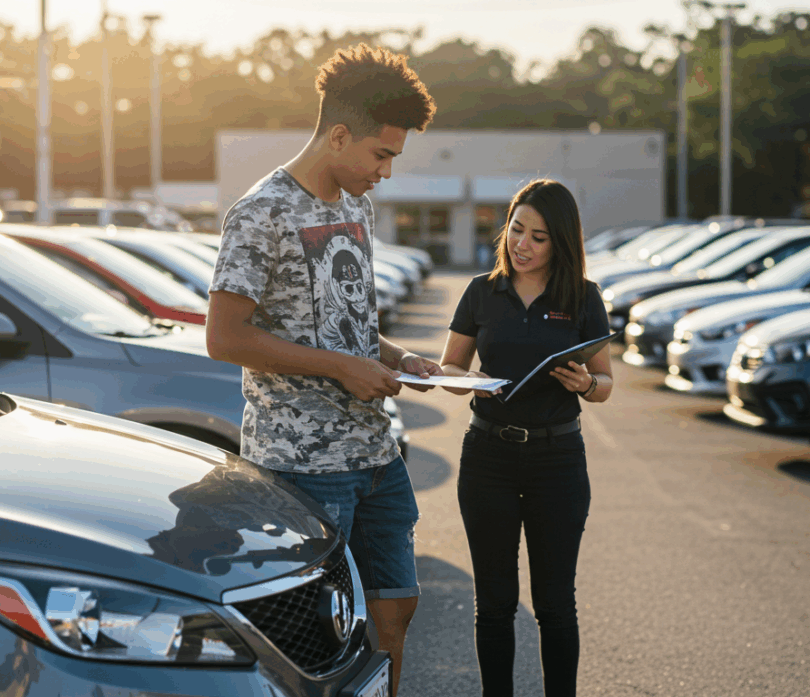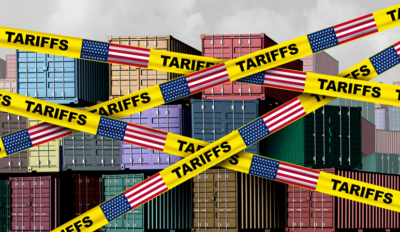How Dealerships Can Win Over the Next Generation of Car Buyers

They’re browsing your site while waiting in line at Starbucks, comparing Google reviews while half-watching Netflix. They’re not searching for dealership content, but if a ‘What To Expect’ video or a real buyer experience shows up in their feed and feels helpful, they’ll watch. This new wave of buyers isn’t just tech-savvy. They’re expectation-savvy. If your experience doesn’t meet them where they are, they’ll scroll right by. The question isn’t if your dealership needs to adapt. It’s how fast.
In this article
- 1 A New Generation, A New Playbook
- 2 Who Are These Next Gen Buyers—and What Do They Actually Value?
- 3 Car Buying Differences: Gen Z vs Millennials
- 4 Where Traditional Dealership Processes Fall Short
- 5 5 Key Strategies to Win Over Next-Gen Buyers
- 5.1 1. Create a Seamless, Mobile-First Experience
- 5.2 2. Show Up Where They Spend Time (and Earn Their Trust There)
- 5.3 Actionable Moves
- 5.4 3. Deliver Flexible, Transparent Financing Options
- 5.5 Actionable Moves
- 5.6 4. Highlight What Matters to Them: Sustainability and Innovation
- 5.7 Actionable Moves
- 5.8 5. Build Loyalty Through Service and Support
- 5.9 Actionable Moves
- 5.10 It’s Not About Changing Who You Are—It’s About Changing How You Sell
A New Generation, A New Playbook
Millennials and Gen Z are no longer tomorrow’s buyers. They’re today’s. And they expect a car buying experience that is online, on-demand, and on their terms. They’re reading your reviews, comparing deals, and running payment scenarios on their phones, often before you even know they’re in the market. They’re not anti-sales, and they’re not anti-dealer. But they are anti-friction.
Winning their business doesn’t mean throwing out what has always worked. It means adjusting how you communicate, how you build confidence, and how you support the sale from first click to final signature. The first step? Understand who they are and what actually drives their decisions.
Who Are These Next Gen Buyers—and What Do They Actually Value?
Millennials and Gen Z buyers now make up a growing share of your store’s customer base. Some are just out of school with their first full-time job. Others are new parents trading out of a sedan. A growing number are moving up from used into their first new car. They’re in different places, but they all expect the process to match how they live and shop.
They’re more informed. More skeptical. And far less tolerant of friction than any generation before them.
This younger generation of buyers grew up in an always-connected world. They’ve been customizing shopping experiences since they were old enough to open a browser tab. They’re comfortable doing their own research – and they often do it long before your team ever gets the lead. By the time they reach out, they’re not asking to be sold. They’re asking for confirmation that your dealership is the right fit.
That’s why understanding what they value isn’t just helpful – it’s essential to winning their business.
What Do They Actually Value?
- Transparency over tactics. They’re not impressed by games. They want to know how the deal works, what the payments look like, and what’s optional versus required.
- Efficiency over process. Speed matters. if they have to fill out a form to get the information they need and If it takes too long to get a response, they’ll move on.
- Authenticity over polish. Real photos, real people, and real answers build trust faster than a slick pitch ever will.
- Control over pressure. Whether it’s online to in-store, or all-digital to delivery, they want to move at their own pace with no surprises.
And here’s the part that matters for every department: these aren’t just buyer preferences. They’re dealmakers and dealbreakers. If your process feels out of sync with their expectations, they won’t ask you to fix it. They’ll simply walk.
4 Trends Your Dealership Can’t Ignore
- They are becoming your core buyer, accounting for 35% of new vehicle registrations, and their influence is growing fast.
- 83% of Millennial and Gen Z buyers prefer to start the process online: They don’t think in departments. They think in steps. If their journey starts online and ends in-store, it should feel like one clear process, not a restart
- Lead response expectations are now under 15 minutes: Slow follow-up doesn’t just disappoint. It disqualifies you.
- Price transparency is the #1 trust factor for buyers under 40: It’s not about offering the lowest price. It’s about offering clarity.
They don’t expect perfection but they do expect consistency across channels and departments. From your website to your Sales team to your F&I office, these buyers expect one connected experience. Not separate steps. And when your internal process breaks that consistency? That’s where frustration starts. And that’s exactly where we’re headed next.
Car Buying Differences: Gen Z vs Millennials
| Category | Millennials | Gen Z |
|---|---|---|
| Buying Motivation | Want practicality, value, and reliability. Often buying for family or commuting. | Lean toward style, tech, and sustainability. View car as personal identity. |
| Digital Expectations | Expect online tools to support the buying process (e.g., trade-in, pre-qual). | Expect full online buying process, especially mobile-first and instant. |
| Dealership Interaction | Value in-person visits for test drives and finalizing financing. | Prefer minimal in-person interaction; like online purchase with curbside pickup. |
| Financing Approach | Comfortable financing; may stretch payments or trade negative equity. | Cautious with debt; want affordable, transparent financing options. |
| Vehicle Priorities | Prefer SUVs, crossovers, and hybrids for practicality. | Drawn to EVs, compacts, and high-tech models. |
| Influence & Research | Use review sites and compare multiple offers; trust established platforms. | Trust creators, short-form video, and peer validation more than brands. |
| Deal Breakers | Turned off by poor service, unclear pricing, or pushy sales tactics. | Avoid dealerships with long waits, poor mobile UX, or lack of transparency. |
Where Traditional Dealership Processes Fall Short
It’s not always the price or the product that causes today’s buyers to walk. More often, it’s the process. And for younger, digital-first shoppers, the cracks show up early.
Many dealerships still treat online and in-store experiences as separate tracks. But your next gen buyers don’t see it that way. To them, it’s one journey, from browsing to final signature. And when those steps don’t align, it creates confusion, doubt, and frustration.
Here’s where the breakdowns usually start:
- Confusing Website Experience.When your online tools don’t reflect real inventory, up-to-date pricing, or realistic payment estimates, trust erodes fast. Shoppers wonder: If the website’s off, what else will be? Add in pop-up overload, competing CTAs, and vague dealerspeak like “Market-adjusted pricing may apply” or “In-transit. Secure your unit today.” None of it feels clear. It feels like a setup. And when buyers sense a bad surprise coming, the whole experience becomes more frustrating than helpful.
- Lead Gen Tactics. Want to know if the vehicle is still available? Lead form. Want to see pricing? Lead form. Want a trade estimate or payment range? Lead form. To Millennial and Gen Z buyers, it feels like a bait-and-switch. They’re not afraid to share their info but only after you’ve earned their trust. If the first step in their journey is a wall, they won’t climb it. If the buyer feels tricked, they won’t push through – they’ll disappear.
- Slow Follow-ups. If your BDC or Internet team takes too long to respond – or worse, replies in a way that doesn’t match the buyer’s preferred communication method – you’ve already lost ground. Gen Z and Millennial shoppers expect fast, respectful replies. And if their communication preference is text or chat, don’t pick up the phone. That’s a red flag. It tells them you’re not listening—and they’ll move on.
- Outdated Credit Experiences. Long forms. Required SSNs up front. Credit apps that feel like tax returns. These create anxiety and stall momentum. If your digital credit flow isn’t intuitive or approachable, younger buyers will bounce before hitting “submit.”
- F&I Surprises. F&I should feel like the final step in the process. Not the start of a second negotiation. But when protection products are introduced after the buyer thinks everything is already locked in, it reopens the deal. Buyers expect those options to be explained, not pitched – and not added at the end like an afterthought. When that happens, it doesn’t feel like protection. It feels like pressure. And that’s when the trust you earned earlier disappears.
These pain points don’t just cause frustration. They create silence. And silence from this next gen buyer doesn’t mean hesitation. It means they’ve moved on.
“Would it stop me from walking? Maybe not always. But I’d sure notice the difference between a store that gets this and one that doesn’t.” – Millennial Car Buyer
So how do you fix it? Not with a complete overhaul, but with smarter steps that meet buyers where they are, from first click to final signature. Let’s walk through four proven strategies to help you connect, convert, and keep more next-gen buyers.
<Insert Image. I will provide>
5 Key Strategies to Win Over Next-Gen Buyers
You’ve seen where the breakdowns happen – and why today’s younger buyers lose trust before the real conversation even starts. The fix isn’t flashier tech or trend-chasing. It’s cleaner execution. Sharper messaging. Smarter timing.
These next five strategies are built to help you remove friction, rebuild trust, and close more next-gen buyers – without cutting price or overhauling your process. And they’re not just for the Internet team. Every department – Sales, BDC, F&I – has a role to play.
1. Create a Seamless, Mobile-First Experience
Today’s buyers don’t “go online.” They live online. And their first impression of your dealership isn’t your showroom. It’s your website, your listings, and how easy it is to take the next step when they’re ready.
If any part of that experience feels clunky, confusing, or like a dead end, they’ll bounce long before they ever engage. A strong digital experience builds trust early. More clarity = more engagement. And a smoother transition from click to close.
Actionable Moves
- If It Doesn’t Work on Mobile, It Doesn’t Work. If your tools work great on desktop but fall apart on mobile, you’re losing deals. Gen Z and Millennials buyers complete every part of the journey – from browsing to credit and beyond – on their phones. Meet them there, or miss them entirely.
- Show real numbers: Sync your credit and payment tools with real credit filters. Or better yet, your actual lender programs. Generic payment ranges kill trust fast, especially when the real numbers change in-store.
- Try Buying a Car on Your Own Site: Seriously. Start on your phone. Can you find what you need?Are the steps clear? Your customer probably doesn’t know what “get e-price” means. Do the filters help them shop the way they actually think – by payment, fuel type, or drivetrain? Are your credit, payment, and trade-in tools easy to find? If anything feels clunky, buyers feel it too.
- Stop Making People Repeat Themselves: Start by eliminating redundant form fills across tools and departments. If a shopper gives you their information once, whether it’s online or in the showroom, they shouldn’t have to enter it again later. Connect your CRM so notes carry forward and your team can pick up right where the customer left off.
- Make Your Trade Tool Worth Using: Integrate with real market data. Be transparent about how values are calculated and how condition or market shifts may affect the final number. Be transparent about ranges and reconditioning. Avoid vague disclaimers. Clarity builds trust.
- Connect with your buyer: Most shoppers avoid form fills – especially on mobile. Tools like live chat, video chat, and AI-powered bots offer faster, easier ways to engage. Just use them with intention. Trigger chat based on behavior (like lingering on a VDP), not immediately on page load. Offer video chat for high-intent buyers who want answers fast or a quick virtual walkaround. And don’t overlook short, embedded explainer videos – like how your trade process works or what credit pre-approval really means. Done right, these tools build trust and momentum. Done wrong, they just add noise.
2. Show Up Where They Spend Time (and Earn Their Trust There)
Younger buyers don’t just research cars online. They research you. They’re checking Google reviews, digging through Reddit threads, scrolling Instagram and TikTok – looking to see if your team feels human… or just like sales scripts in polos.
And if all they see are generic ads, low-effort inventory posts, and your last video was from 2023? They’ll scroll right by.
Social isn’t just marketing. It’s your digital showroom. It’s how this generation sizes you up before they ever click “contact.” The goal isn’t to go viral. it’s to be real, present, and trustworthy.
Actionable Moves
- Pick two platforms and commit. You don’t need to be everywhere, just consistent where it counts. Instagram and TikTok are smart bets, but not everyone’s built for TikTok. Some teams will crush it on Facebook Live or Instagram Reels. The best platform is the one your team will actually use. Either way, post regularly, respond to comments, and let your real team show up – not just your logo or latest price drops.
- Feature your people, not just your product. Put your staff on camera. Celebrate happy customers. Show what your team’s up to between deals. What feels ordinary to you builds familiarity and trust with buyers. Bonus: real people content also performs better in most algorithms.
- Use short-form video with purpose. Quick trade-in tips. How-to videos on credit pre-approval. Simple walkarounds. These don’t need to be polished, just helpful and real. That’s what makes them work. Answer real customer questions. Use your videos to respond to what people are actually asking in comments and DMs. Whether it’s “Do I really need to get pre-approved?” or “How long does a trade-in take?” This kind of content feels personal, community-driven, and trustworthy.
- Turn comments and DMs into conversations. Don’t just “heart” a comment. Reply like a human. Ask follow-ups. And treat DMs like gold. They’re the new phone call. The best part? When you get the same question more than once, it’s a perfect short-form video idea. That’s how you turn feedback into content that actually helps.
- Ditch the corporate voice. You’re not writing a commercial. You’re starting a conversation. Drop the buzzwords. Be direct, clear, and honest. If you can be a little funny or even a little sarcastic, that’s even better. Let your customers do the talking too: highlight real reviews, repost buyer testimonials, and share user-generated content. It’s more believable, and next-gen buyers trust it more than anything you say about yourself.
- Show, don’t say, you’re trustworthy. Reviews are great. But how you respond to them matters more. Reply to negative ones with empathy, not defensiveness. Highlight five-star reviews in Stories (those vertical, real-time updates on Instagram and Facebook that show up at the top of people’s feeds and disappear after a day.) And if you’re running a promo, explain the fine print. That kind of clarity builds credibility fast.
3. Deliver Flexible, Transparent Financing Options
Price matters, but for this generation of buyers, how the deal is structured often matters more. Most are shopping by monthly payment, not MSRP. And with affordability becoming a bigger challenge, the path to “yes” needs to feel realistic and manageable.
These buyers, unlike previous generations, are not chasing zero percent financing or expecting huge discounts. What they want is clarity. They want to understand their options, know how the numbers work, and feel like they are participating in the process — not just the paperwork
That means moving beyond vague payment estimates and taking time to explain the “why” behind each rate, term, or offer. When financing feels fair and well-structured, buyers are more confident saying yes, and your team doesn’t have to give up gross to get there.
Actionable Moves
- Structure deals around real buyer goals. Start with what matters most to them, usually the monthly payment. Know your lender’s sweet spots. Some buyers are better matched with longer terms. Others qualify for lower rates with minimal reserve hit. Use your F&I team to find the right fit. Flexibility doesn’t mean losing gross. It means structuring smarter.
📣 Pro Tip: Normalize questions. Let these younger buyers know it’s okay to ask things like “What’s the benefit of a longer term?” or “What does GAP cover?” That creates trust and makes them feel more informed.
- Explain the “why” behind the payment. Break down what goes into the offer – term, rate, taxes, lender program, protection products – so buyers feel informed, not sold. Gen Z and Millennials respond to transparency. They want to understand the full picture. The more they understand, the more likely they are to say yes.
📣 Pro Tip: Use visuals. A quick iPad walk-through or one-pager with a real quote breakdown builds clarity and trust.
- Promote financing as part of the value, not just a step. Your financing process can be a real differentiator. Promote flexible terms, helpful tools, or faster pre-approvals in your ads, website, and conversations. Focus on how you help buyers find the payment that fits – not just push them to sign. That’s what builds trust and gives your store a competitive edge.
📣 Pro Tip: Share real examples. Highlight stories like “Steve got pre-qualified and drove home on their lunch break.” That makes your process feel real and relatable.
- Offer clear lease vs. buy comparisons. Help buyers understand both options. Show the pros and cons of both. Put the numbers side by side – payments, equity position, warranty coverage – and walk them through it. Clarity builds confidence and moves the deal forward.
📣 Pro Tip: Add a lease vs buy comparison calculator to your website, or have your BDC team send one as part of the follow-up. These next gen buyers appreciate tools they can explore on their own.
4. Highlight What Matters to Them: Sustainability and Innovation
Younger buyers aren’t just choosing a car. They’re choosing what it says about them. For many, that means looking beyond horsepower and monthly payments to values like fuel efficiency, sustainability, and smart technology.
This doesn’t mean every Millennial or Gen Z buyer wants an EV, but it does mean they’re paying attention to what brands and dealers stand for. If your store is offering hybrids, PHEVs, or fuel-efficient gas models, lead with it. If you’ve gone paperless or started offering mobile services, talk about it.
Even small changes show that your dealership is adapting, not standing still. That’s what builds relevance and makes you stand out from the store down the street.
Actionable Moves
- Promote high-efficiency and tech-forward inventory. Don’t assume every buyer is looking for a full EV. Many next-gen shoppers are focused on fuel savings, lower maintenance costs, and modern features. Hybrids, PHEVs, and fuel-efficient gas models often hit that sweet spot.
Make it easy to compare ownership costs. Highlight maintenance savings, fuel cost estimates, or projected five-year ownership costs on your VDPs. Real-world savings matter more than horsepower specs.
Create a “Smart Drive” filter or landing page to group these vehicles. On that page, use real-world language, not just specs. Say things like “Great for commuters,” “Easy to park,” or “Under $75 per month to fuel” instead of listing only MPG ratings and tech packages.
- Showcase your dealership’s eco and tech efforts. If you’ve gone paperless, installed solar panels, added EV chargers, or started recycling parts, don’t keep it to yourself. You don’t need a full-blown green initiative to show progress.
A short “behind the scenes” post on Instagram Stories or a quick Reel can shape perception more than an expensive ad campaign. Even something simple like “Ever wonder what happens to your old trade-in?” can highlight your process in a way that feels modern, relatable, and real.
- Make Your Online Tools and Content Build Trust, Not Friction Younger buyers are not impressed by flash. They want tools and content that actually help. The best experiences save time, reduce pressure, and build confidence.
Let them interact with your online tools the way they naturally shop, without being required to complete a form fill first. For example, let them try your trade-in tool by entering the basics – year, make, and model – and then offer to refine the number once they are engaged.
Show short demo videos of features like Apple CarPlay, digital dashboards, or hybrid drive modes. These can be filmed by your team or sourced from your OEM. A walk-through from someone at your store feels more relatable than a polished factory video.
In the service lane, use digital inspection videos. A quick clip from your technician showing what is working and what needs attention helps buyers feel informed, not pressured. It builds trust and makes approvals easier.
5. Build Loyalty Through Service and Support
Winning the sale is just the beginning. For Millennial and Gen Z buyers, loyalty doesn’t come from one good deal. it comes from how you follow up, how you stay connected, and how easy you make it to come back.
These buyers are used to personalized offers, proactive communication, and services that meet them on their terms. If your post-sale experience still relies on mass emails and basic reminders, you’re leaving retention on the table.
Loyalty today means earning the next visit before the buyer ever thinks to shop around. The good news? A few smart touchpoints and simple tools can turn one-time buyers into long-term customers.
Actionable Moves
- Make service follow-up feel personal. Generic blasts get ignored. But a quick message that references the customer’s last visit, vehicle, or concern feels thoughtful. Use first names and tie it to real service history.“Hey Jamie, your last tire rotation was back in March. Want to get ahead of the summer heat?” Add a one-click booking link to keep it easy.
- Promote service-to-sales offers. Service visits are your best shot at earning the next sale. Just keep it consultative. A soft, data-backed message works better than a sales pitch.“Want to see what your Civic’s worth right now? Tap here. No strings.” Include a trade valuation link to turn interest into action without pressure.
- Offer mobile-friendly service tools If customers have to call or wait on hold, it feels outdated. Let them book online, approve repairs by text, and pay on their phone. Want to stand out? Add real-time repair updates:“Your car is in the bay now. Estimated completion: 2:15 p.m.” That small touch builds peace of mind and brand confidence.
- Reward loyalty in ways that matter. Punch cards and points aren’t it. Give buyers time- or money-saving perks that feel relevant.“Your next oil change is free—thanks for being a loyal customer.” Or let loyal customers get first look at new inventory before it’s listed.
- Stay in the feed after the sale. Shout out returning customers, not just new buyers. Share quick stories, tag happy customers, or post service milestones.“Back for her third service visit—always great to see familiar faces!” This shows you care beyond the sale and keeps you top of mind.
- Offer a real person they can reach. Automation is fine. Until there’s a problem. End your texts or emails with a human option.“Got a question? Text me here or call Lisa in service at 555-1234. She’s awesome.”That small gesture adds trust, warmth, and accountability.
It’s Not About Changing Who You Are—It’s About Changing How You Sell
You don’t need to abandon what’s always worked. But you do need to evolve how you connect, communicate, and close.
Millennials and Gen Z buyers aren’t hard to sell to. But they are quick to disengage if the experience feels outdated, unclear, or impersonal. They expect speed, clarity, and a sense that your store understands how they shop, how they think, and what makes them say yes.
The good news? Meeting those expectations doesn’t mean cutting gross or chasing trends. It means tightening your process, showing up where they spend time, and turning every step from mobile shopping to service follow-up into a smoother, smarter experience.
Dealerships that make these shifts will not only earn next-gen buyers. They will keep them coming back.



